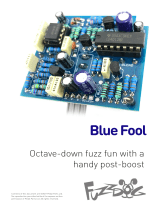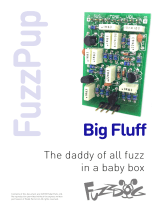Page is loading ...

Super Skwisher
Ross Compressor +++
Contents of this document are ©2015 Pedal Parts Ltd.
No reproduction permitted without the express written
permission of Pedal Parts Ltd. All rights reserved.

Important notes
If you’re using any of our footswitch daughterboards,
DOWNLOAD THE DAUGHTERBOARD DOCUMENT
•Download and read the appropriate build document for the
daughterboard as well as this one BEFORE you start.
•DO NOT solder the supplied Current Limiting Resistor (CLR) to the
main circuit board even if there is a place for it. This should be
soldered to the footswitch daughterboard.
COMPONENT SPECS
Unless otherwise stated in this document:
•Resistors should be 0.25W. You can use those with higher ratings but
check the physical size of them.
•Electrolytics caps should be at least 25V for 9V circuits, 35V for 18V
circuits. Again, check physical size if using higher ratings.
LAYOUT CONVENTIONS
Unless otherwise stated in this document, the following are used:
•Electrolytic capacitors:
Long leg (anode) to square pad.
•Diodes:
Striped leg (cathode) to square pad.
•ICs:
Square pad indicates pin 1.

Important OOPS!
The lastest run of the PCB was produced without labelling
on some of the pads.
They follow the standard Direct Connect layout:

The schematic above shows everything that is on
the PCB. Since the board is designed for several
different builds, not everything is used on each
build. The following pages will show only the parts
of the schematic relevant to each particular build,
though components not shown will still be
referenced in the BOM where a jumper is required
or it is left empty.
The cover image shows the previous version of
the PCB, prior to the addition of the LM13700.
Actual layout is below. CA3080 goes into the
pads marked in blue, LM13700 in red. See page 8
for a shot of a build on the latest PCB.
Schematic - full board
PCB Layout ©2015 Pedal Parts Ltd. All rights reserved.
General Notes
The power and signal pads on the PCB
conform to the FuzzDog Direct Connection
format, so can be paired with the
appropriate daughterboard for quick and
easy offboard wiring.
Be very careful when soldering the diodes.
They’re very sensitive to heat. You should
use some kind of heat sink (crocodile clip
or reverse action tweezers) on each leg as
you solder them. Keep exposure to heat to
a minimum (under 2 seconds). You should
use a socket for the IC, or be super careful
not to overheat. Take your time.
Snap the small metal tag off the pots so
they can be mounted flush in the box.
Though the LM13700 isn’t shown on the
schematic, it can simply replace the
CA3080 in the build. Place it in the IC2
position. The legs correspond like this:
CA3080 LM13700
24
33
46
51
65
7 11
As long as you put your LM13700 in the
pads shown left it’s all done for you.

Stock Ross Compressor
R1 2M2
R2 10K
R3 470K
R4 470K
R5 10K
R6 10K
R7 1M
R8 1M
R9 220K
R10 220K
R11 15K
R12 150K
R13 10K
R14 10K
R15 1M
R16 27K
R17 1M
R18 10K
R19 150K
R20 Jumper
R21 56K
R22 27K
R23 2K2 (CLR)
R24 Empty
C1 10n
C2 220p*
C3 1u
C4 1u
C5 1u
C6 10u
C7 1u
C8 10u
C9 10u
C10 1u
C11 10n
C12 10n
C13 47n
C14 10n
C15 1n
C16 10n
C17 Empty
C18 Empty
D1 1N4001
D2,3 1N4148
Q1-5 2N5089
IC CA3080
T1 2K2
SUST 500KB/C**
LEVEL 50KA
CLIP Jumper 2 + 3
ATTACK Empty
S1 Empty
*100p will remove less treble than stock.
**Originally linear (B), but reverse-log (C) is better.
Put a jumper wire between pads 2 + 3 of CLIP.
To set the trimmer turn the Sustain pot up to full and
adjust trim for maximum sustain with no distortion.

R1 2M2
R2 10K
R3 470K
R4 470K
R5 10K
R6 10K
R7 1M
R8 1M
R9 220K
R10 220K
R11 15K
R12 150K
R13 10K
R14 10K
R15 1M
R16 27K
R17 1M
R18 10K
R19 150K
R20 10K
R21 56K
R22 27K
R23 2K2 (CLR)
R24 39K
C1 10n
C2 220p
C3 1u
C4 1u
C5 1u
C6 10u
C7 1u
C8 10u
C9 10u
C10 1u
C11 10n
C12 10n
C13 47n
C14 10n
C15 1n
C16 10n
C17 1n5
C18 Empty
D1 1N4001
D2,3 1N4148
Q1-5 2N5089
IC CA3080
T1 2K2
SUST 500KB/C
LEVEL 50KA
CLIP Jumper 2 + 3
ATTACK Empty
S1 SPDT ON-OFF-ON
See notes from previous page.
The SPDT switch will give you three different recovery
settings.
C17 will give more treble response.
Mark Hammer Mods

*In the original unit T1 is replaced by two 1K resistors.
A 2K2 trimmer set in the middle position will give the
same result and allow extra adjustment.
**150KB will be hard to source. See notes on next page.
R1 4M7
R2 10K
R3 470K
R4 470K
R5 10K
R6 10K
R7 1M
R8 1M
R9 220K
R10 220K
R11 15K
R12 150K
R13 10K
R14 10K
R15 1M
R16 27K
R17 1M
R18 10K
R19 Empty
R20 Jumper
R21 56K
R22 27K
R23 2K2 (CLR)
R24 Empty
C1 10n
C2 150p
C3 1u tant
C4 1u
C5 1u
C6 1u
C7 1u
C8 10u
C9 10u
C10 1u
C11 10n
C12 10n
C13 47n
C14 10n
C15 1n
C16 10n
C17 Empty
C18 2n2
D1 1N4001
D2,3 1N4148
Q1-5 2N3904
IC CA3080
T1 2K2*
SUST 500KC
LEVEL 50KB
CLIP 150KB**
ATTACK 150KB**
S1 Empty
Boutique 4-Knob

These are the CLIP pads that need jumpering
on the Stock and Hammer builds.
Those awkward 150KB Pots...
Not something that’s on every supplier’s stock list, so will be difficult to source. You
have couple of options here:
•Use 250KB and live with it. You get extra adjustment range that you may or
may not find useful. It’s not the end of the world.
•Use 250KB and add resistors in parallel to get closer to 150KB. This will,
unfortunately, change the sweep of the pot which may make it less useable
than the extra range given by the first option. The good thing is, you can try
option 1, add the resistors and see
how it works, then simply snip them
back off if you don’t like it.
To add the resistors, just solder them
across pads 1 & 3 of both pots as
shown.
A 250K pot in parallel with a 390K
resistor will give you 152K. Close
enough!
Replace the trimmer
Place the two 1K resistors for the 4-knob
version like this>>>

...and here’s a build on the newer PCB with the LM13700.
This is a two-knob with Hammer mods switch.
Note: the CLIP jumper has changed position since this build.

Test the board!
Check the relevant daughterboard document for more
info before you undertake this stage.
UNDER NO CIRCUMSTANCES will troubleshooting help
be offered if you have skipped this stage. No exceptions.
Once you’ve finished the circuit it makes sense to test is before starting on the switch and LED
wiring. It’ll cut down troubleshooting time in the long run. If the circuit works at this stage, but it
doesn’t once you wire up the switch - guess what? You’ve probably made a mistake with the switch.
Solder some nice, long lengths of wire to the board connections for 9V, GND, IN and OUT. Connect
IN and OUT to the jacks as shown. Connect all the GNDs together (twist them up and add a small
amount of solder to tack it). Connect the battery + lead to the 9V wire, same method. Plug in. Go!
If you’re using a ribbon cable you can tack the wires to the ends of that. It’s a lot easier to take them
off there than it is do desolder wires from the PCB pads.
If it works, carry on and do your switch wiring. If not... aw man. At least you know the problem is
with the circuit. Find out why, get it working, THEN worry about the switch etc.
Your completed circuit board
including pots

(if using a daughterboard please refer to the relevant document)
Wire it up - DC only version
This circuit is standard, Negative GND. Your power supply should be
Tip Negative / Sleeve Positive. That’s the same as your standard pedals
(Boss etc), and you can safely daisy-chain your supply to this pedal.
The BOARD GND connections don’t all have to connect to one point.
They can be daisy-chained around the circuit, using larger connection
points (such as jack socket lugs) for multiple connections. As long as
they all connect together in some way.
L
E
D
BOARD
OUT
BOARD
9V
BOARD
GND
BOARD
GND
BOARD
GND
BOARD
INPUT
+
IN
OUT
L
E
D
BOARD
GND
BOARD
LED+

(if using a daughterboard please refer to the relevant document)
Wire it up - with battery
This circuit is standard, Negative GND. Your power supply should be
Tip Negative / Sleeve Positive. That’s the same as your standard pedals
(Boss etc), and you can safely daisy-chain your supply to this pedal.
The BOARD GND connections don’t all have to connect to one point.
They can be daisy-chained around the circuit, using larger connection
points (such as jack socket lugs) for multiple connections. As long as
they all connect together in some way.
FuzzDog.co.uk
L
E
D
BOARD
OUT
BOARD
9V
BOARD
GND
BOARD
GND
BOARD
GND
BOARD
INPUT
BATTERY
+
IN
OUT
L
E
D
BOARD
GND
BOARD
LED+
+
Just because the
FuzzDog enclosure
won’t take a battery,
there’s nothing
stopping you using a
bigger box.

Drilling template
Hammond 1590B
60 x 111 x 31mm
Recommended drill sizes:
Pots 7mm
Jacks 10mm
Footswitch 12mm
DC Socket 12mm
Toggle Switch 6mm
This template is a rough guide only. You should ensure correct marking of your
enclosure before drilling. You use this template at your own risk.
Pedal Parts Ltd can accept no responsibility for incorrect drilling of enclosures.
FuzzDog.co.uk
It’s a good idea to drill
the holes for the pots
1mm bigger to give
yourself some wiggle
room, unless you’re a
drill ninja.
32mm
27mm
14mm
/















